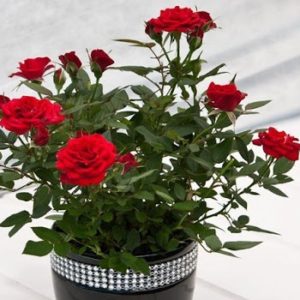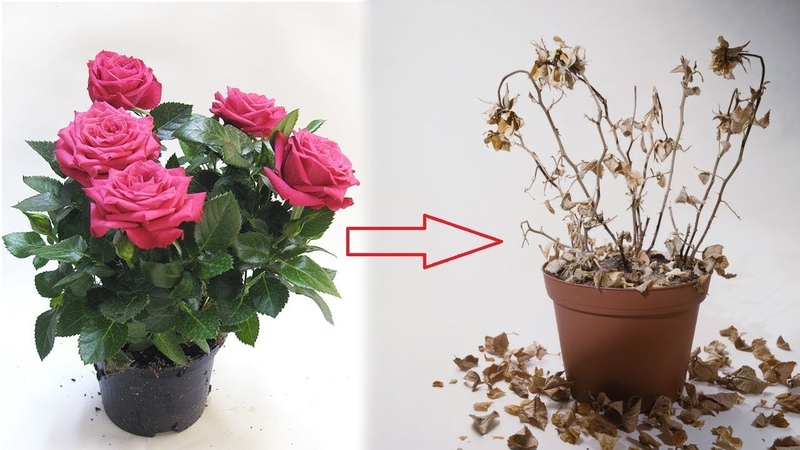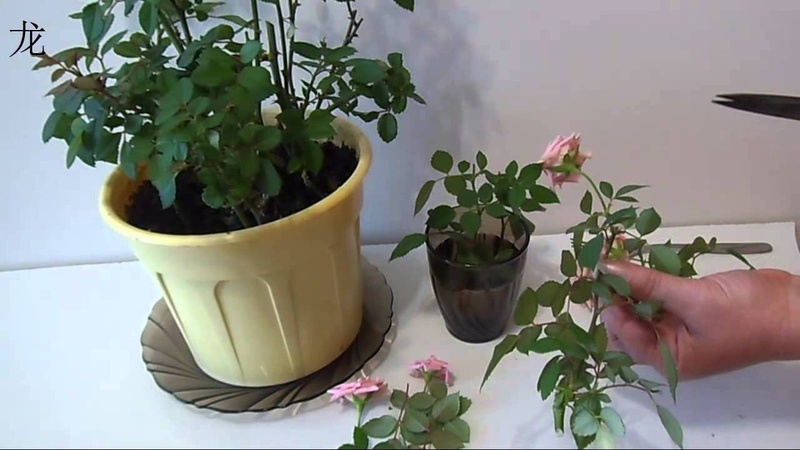How to care for a home potted rose - a beginner's guide
The rose is considered the queen of all colors. It is grown outdoors, in greenhouses and even at home. Bengal, polyanthus and remontant varieties are usually chosen as a houseplant. However, some flower growers keep roses grown from a donated bouquet in their apartment. Such plants delight the owner with long flowering for many years.
Indoor roses are capricious and demanding to care for. So that they develop correctly, do not get sick and bloom profusely, it is important to pay enough attention to them and provide optimal conditions for detention. How to care for a home rose in a pot, we will tell you in the article.
The content of the article
Optimal conditions for indoor roses
Indoor roses are sensitive to negative environmental factors.
Growing conditions for decorative roses:
- Temperature. In spring, summer and in the first half of autumn, the optimum temperature for keeping a rose varies between + 20 ... + 25 ° C. The plant will not be damaged by temperature fluctuations from +18 to + 30 ° C. At the end of autumn and in winter, the rates decrease to + 10 ... + 17 ° C.
- Humidity. Humidity should be high - 75-80%. Dry air causes leaves and shoots to wilt, and also increases the likelihood of infection with diseases and pests. Hot dry air is especially dangerous if a flower pot is near a heater.
- Lighting. In order for a bush rose to receive enough light, it is placed on a southern, southeastern or eastern window sill. If the plant is on the southern windowsill, from 11 to 16 o'clock the window will have to be shaded with translucent tulle. It is not necessary to use additional lighting sources.
The rose does not tolerate sudden changes in temperature. Before you take the plant outside, bring it into the house or send it to a room with low temperatures for the winter, it is important to let it get used to it. For this, the flower bush is placed in new conditions, first for half an hour, then for an hour, two, etc. Every day, the time is increased until it reaches a day. After that, the rose is left there for good.
Drafts are destructive for a flower. In the cold season, you cannot open the window on the window on which the plant stands. Also, the rose is not kept under conditioner.
Hot dry air is dangerous for a room rose. If it is standing on the windowsill, under which there is a working heating device, a damp cloth is placed on it, and on the windowsill they make a side made of insulation with a foil side.
Note! In early spring or late autumn, when the heating is on, but the plant is not overwintering, it is important to use a humidifier. These can be special devices or containers with water, placed near the bush.
Requirements for capacity and soil

To grow a healthy, well-formed plant, it is important to find the right container. You cannot immediately take a large pot - in this case, the roots will not form correctly, the plant will begin to fatten, flowers will not form on it.
If the plant is bought in a store, it is transplanted into a container, the volume of which will be 200-400 ml larger than the previous one. The rooted stalk is first planted in a container with a volume of 300-500 ml, and then, as the pot is filled with roots, its volume is increased.
Clay and ceramic containers are best suited for indoor spray roses. They absorb moisture by the walls, which prevents liquid stagnation and drying out of the soil.Air also enters the soil through the pores in the walls of such pots.
Plastic containers are also used. However, they do not have the same advantages as ceramic ones.
It is important that there are drainage holes in the bottom of the pot. They will prevent moisture stagnation and root rot. The containers are disinfected - doused with boiling water or soaked for 30 minutes in a dark pink solution of potassium permanganate.
The soil for flowering plants is suitable for roses. Experienced gardeners do not recommend using a universal soil mixture, as it usually contains a lot of high peat, which increases the acidity of the soil.
Prepare it yourself. To do this, mix:
- garden land - 2 parts;
- sheet - 2 parts;
- humus - 1 part;
- sand - 1 part.
Add 1 tbsp to a bucket of the resulting mixture. ash. Then the soil is disinfected by pouring it with a dark pink solution of potassium permanganate, an antifungal agent ("Fitosporin"), a solution of copper sulfate (1 tsp of the substance per 3 liters of water) or by igniting it in the oven.
Note! White or gray sand is added to the soil for indoor plants. Yellow and ginger contain a lot of iron, which negatively affects plants.
In addition to soil and containers, you will need drainage to grow roses at home. Usually they use broken ceramics, fine gravel and expanded clay, shell rock or commercially available filler. The drainage is disinfected with a dark pink solution of potassium permanganate or copper sulfate.
Rules for caring for a rose in a pot
Regardless of the color of the buds, the size and variety of the bush, care for the rose (hibiscus) is the same. It is important to regularly take care of the indoor flower, to provide it with proper watering, feeding, shaping and transplanting.
Watering

For watering roses, use settled water at room temperature. Melt and rain are especially useful. Water the plant early in the morning or evening when the sun is inactive. Otherwise, burns will remain on the leaves.
In the warm season, the rose is watered as the topsoil dries. This is usually done every 2 days. Watering should be frequent, but not abundant.
In winter, the amount of watering is reduced. The soil is moistened on average once a week.
To provide the plant with optimal humidity in the warm season, it is sprayed every other day with warm, settled water. The procedure is carried out in the morning or in the evening. This will prevent spider mite infestation.
Once a month, the rose is washed under the shower with warm water or the leaves are wiped with a damp cloth. In this case, it is better to cover the soil in the pot with a film.
Advice! To prevent waterlogging and drying out of the soil, bottom watering is used. To do this, water is poured not into a pot, but into a pan so that the earth absorbs the required amount of liquid.
Top dressing
Fertilizers are applied from spring to autumn. They use organic and mineral complexes. In the store, you can buy special compositions for roses and flowering plants, or prepare top dressing yourself.
The list contains several popular recipes:
- Mullein solution. Mullein is diluted with water in a 1: 2 ratio and insisted for a week. Then diluted with water in a ratio of 1:15. For one adult plant in a pot, use 0.5 liters of fertilizer.
- Chicken droppings. 1 part of litter is diluted with 2 parts of boiling water and infused for 4 days. The resulting concentrate is diluted with water in a ratio of 1:25.
- Mineral dressing. In 10 l of water, 30 g of superphosphate, 15 g of ammonium nitrate and 20 g of potassium sulfate are dissolved.
- Ash. In 5 liters of water, dilute 1 tbsp. ash. Before use, the product is infused for 24 hours.
- Food waste. With peelings of vegetables and fruits, fill the container 1/3. The rest of the volume is poured with warm water. The ingredients are allowed to brew for a week. Before use, dilute with water in a ratio of 1: 3.
Foliar dressing is useful once every 2 weeks. Usually they use special fertilizers (for example, "Cascade"), diluted according to the instructions.
To prevent burns on the roots, the day before fertilizing the soil is watered with warm water.Feeding roses when the sun is inactive.
Pruning
Pruning is carried out twice a year: in spring and autumn. The technique is different.
In the spring, branches are removed, directed inside the bush. Dried shoots, as well as damaged parts with signs of infection with diseases and pests are cut off.
During the entire warm period, faded buds are removed along with the shoots on which they are located. Tear off yellowed and dried leaves.
In autumn, the plant is pruned so that 3 to 5 buds remain on each branch. Pruning is used to grow roses from cuttings.
Autumn pruning rejuvenates the plant. If not carried out, the rose will bloom later. The bush will be less flavorful.
Transfer
Transplant the plant as the container is filled with roots. The younger the rose, the more often it needs transplants.... So, in the first year (if the rose is grown from a cuttings), at least 2-3 transplants will be required. More mature flowers are transplanted once a year.
To transplant roses, use the transshipment method. The day before the procedure, the plant is prepared - it is poured abundantly with warm water, allowing the liquid to be completely absorbed.
The rose is taken out of the pot along with a lump of earth, trying not to damage the roots. They are being examined. If rotten and very dark roots peep out of the coma, the earth is removed, the damaged areas are removed. Healthy roots are treated with a solution of copper sulfate (1 tsp for 3 liters of water).
If the roots are healthy, only the drainage layer is removed. It is also recommended to remove a layer of earth at least 2 cm thick in the upper part.
A drainage layer is poured into a new disinfected container. The rest of the volume is filled with soil, compacting it. After transplanting, the soil is moistened with warm water.
The day after the procedure, the pot with the bush should be in a dark place. Then it is rearranged on the windowsill. To reduce stress from the procedure, the plant is sprayed with a growth stimulant, for example, "Epin".
A plant purchased in a store must be transplanted into a new pot. They don't do it right away. First, he is allowed to stand at the window in the apartment for at least a week, so that it adapts to new conditions.
When transplanting a purchased rose, most of the old soil is removed, being careful not to damage the roots. If complex fertilizer granules are visible in the root system, they are left.
Advice! Experienced flower growers recommend handling the plant on the growing moon.
Protection against diseases and pests

At home, roses get sick much less often than in the open field. Houseplants infect the following diseases and pests:
- Rust. Fungal disease manifests itself in the form of red convex formations, spots or streaks on the leaves and shoots. Over time, red powder begins to pour from them. This causes the plant to dry out. To cope with the problem, the rose is treated with Fitosporin. If medications do not help, fungicides are used.
- Powdery mildew... A fungal disease in which a whitish coating appears on the leaves. Over time, it becomes denser and darkens. The plant dries up. They fight the disease using Fitosporin or folk remedies. One of the recipes: 15 drops of iodine and 1 liter of milk in 5 liters of water.
- Spider mite... A pest that feeds on plant sap. Small bugs and cobwebs appear on the underside of the leaves. To get rid of the pest, plants are sprayed with folk remedies, for example, with a soap-ash solution, or treated with insecticides.
- Aphid. Whole colonies of small green or black insects appear on rose bushes, which feed on plant sap. They fight aphids in the same way as with a spider mite.
Reproduction

It is not necessary to purchase a rose bush from a store. At home, the plant is propagated by cuttings, using cuttings obtained after formation, or stems of roses from a bouquet.
Cuttings should be 10-15 cm long and 3-4 living buds. When receiving planting material, the lower cut is made at an angle, and the upper one is even.
The cuttings are soaked for 30 minutes in a light pink solution of potassium permanganate. Then they are dipped in a dry growth stimulant, for example, Kornevin.
The rose is rooted in soil, water, sand and even potatoes. The most convenient option is the soil. In this case, the cutting will not have to be transplanted into a new container when it takes root.
The shoot is placed in the ground so that it stands unsupported, and one bud is underground. The plant is covered with a bag or cut bottle.
The rose is aired daily for 15 minutes. The soil is moistened as it dries, and the cutting is sprayed with water at room temperature.
Leaves and shoots formed on seedlings testify to their rooting. At this time, the duration of airing is gradually increased, bringing it to a day.
If the cutting is rooted in the ground, it is transplanted into another container only after the root system fills the previous one. If the rose is rooted in water, the plant is planted in the ground immediately after the roots appear.
Features of care at different times of the year

At different times of the year, there are peculiarities of plant care.
Summer
In the summer, plant care should be especially careful. On hot days, it is watered daily or 2 times a day. Regular feeding, cutting wilted buds, loosening the soil are necessary. It is important to protect the plant from the heat. If its leaves begin to dry out and wither, the pot is moved to a shaded place. In order for the flower to develop evenly, it is periodically turned in relation to the window. If possible, it is better to keep the rose on the balcony or in the garden at this time of year.
Fall
When the nights get cold, the rose is brought from the balcony or garden into the house. She is examined for traces of diseases and pests. Remove dry and damaged shoots. After the plant stops blooming, remove all wilted buds and carry out autumn pruning. Gradually reduce the frequency of watering. When the topsoil is dry, wait another 2-3 days before watering. Stop feeding. The pot is taken out to a cool room, where wintering will take place, gradually increasing the time spent there.
Winter
In winter, the rose sheds the remnants of the leaves. The grower is required to moisten the soil once a week. The flower should be in a cool room at rest. Otherwise, it will not recover until spring, and the flowering will not be plentiful.
Spring
The rose is brought into a warm room. Increase the frequency of watering, begin to apply top dressing, carry out preventive treatments and pruning. Transhipment of plants is done during this period.
It is interesting:
How to properly grow tulips in a pot at home
Description of varieties and features of growing terry petunia
Growing petunias at home and in the open field: necessary conditions, planting, care
Conclusion
Growing a room rose at home requires attention from the grower and compliance with the rules of care, since the plant is sensitive to adverse environmental factors.
To make it feel comfortable, it is important to provide it with proper watering, regular feeding and pruning, annual transplants and a comfortable winter, as well as protect it from diseases and pests.